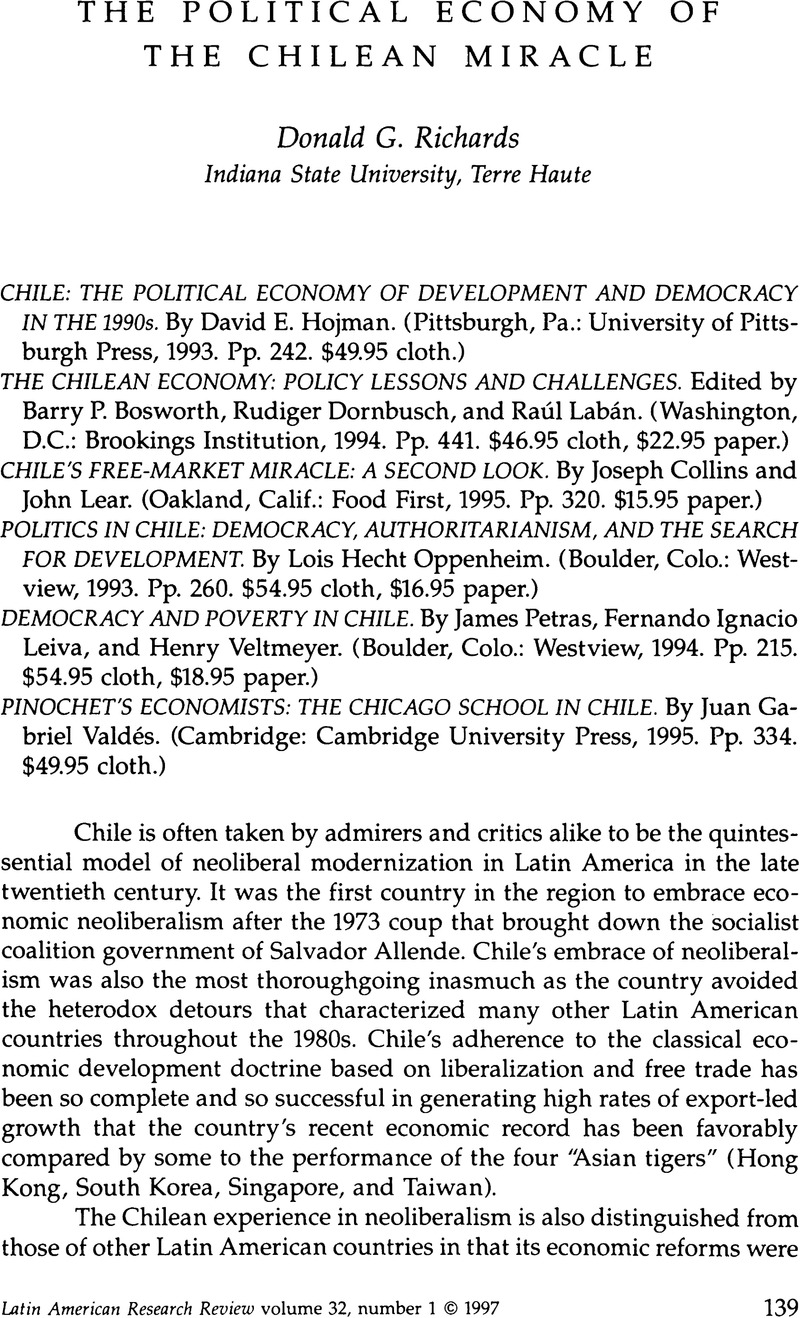Published online by Cambridge University Press: 05 October 2022

1. Representative works include Paul E. Sigmund, The Overthrow of Allende and the Politics of Chile, 1964–1976 (Pittsburgh, Pa.: University of Pittsburgh Press, 1977); Jim Stickter, Allende and the Saga of Chile (Corpus Christi, Tex.: Hemisphere House, 1976); and James R. Whelan, Allende: Death of a Marxist Dream (Westport, Conn.: Arlington House, 1981).
2. Hojman also considers the term Chicago boys potentially pejorative in that the expression could conjure up images of Capone-style gangsterism (p. 22).
3. Valdés notes that the Universidad Católica became the logical recipient of the transmitters of the neoliberal doctrine (under the International Cooperation Agreement of the U.S. government working with the University of Chicago) precisely because its economics department was comparatively weak (pp. 117–18). The lack of internal academic competition gave the Chicago boys a great opportunity to become a dominant force in the institution. The fact that the ICA and the University of Chicago provided funding to support a full-time professor of economics at Universidad Católica further enabled the Chilean university to establish itself in relative isolation from the political scene prevailing nationally.
4. The tablita refers to the schedule of preannounced mini-devaluations.
5. Portfolio flows are equity investments that do not endow the investor with a controlling share of ownership in the affected firm.
6. Moisés Naím noted that the Chilean stock market dropped 12 percent in the first quarter of 1995, following the Mexican devaluation. See Naím, “Latin America the Morning After,” Foreign Affairs 74, no. 4 (July–Aug. 1995):45–61, 49.
7. Marcel and Solimano note in The Chilean Economy that the degree of income inequality in Chile exceeds that of Asian countries and those belonging to the Organisation for Economic Cooperation and Development. Among Latin American countries, only Peru and Brazil are more extreme in distribution of income (p. 219).
8. These ratios were calculated based on data provided by Statistical Abstract of Latin America, edited by James W. Wilkie (Los Angeles, Calif.: UCLA Latin American Center, 1993).
9. See for example R. G. Lipsey and K. Lancaster, “The General Theory of the Second Best,” Review of Economic Studies 24 (1956–1957):11–32.
10. Hojman's empirical estimations show instead that a decrease in unemployment is the best predictor of improvement in infant mortality. Thus the best anti-poverty policies are the ones that increase employment among the poor.
11. In 1987 the Pinochet regime passed a law on political parties specifying prerequisites for groups seeking to establish legal status as political parties.
12. The idea that Latin American leftist intellectuals have broken faith with formerly espoused principles and positions is considered at length by Petras in “Retreat of the Intellectuals,” in James Petras and Morris Morley, Latin America in the Time of Cholera: Electoral Politics, Market Economics, and Permanent Crisis (New York: Routledge, 1992). It is interesting to compare Petras's view with that of Hojman in “The Political Economy of Recent Conversions to Market Economics in Latin America,” Journal of Latin America Studies 26, pt. 1 (1994):191–219. Hojman also argues that the emergence of an intelligentsia committed to the neoliberal vision is a key factor in recent market success in Latin America.
13. In a recent review, Barbara Geddes argued that the evidence reveals no particular relationship between authoritarianism and liberalization. It would seem, however, that comparisons between national experiences in these terms must consider particular historical circumstances. See Geddes, “The Politics of Economic Liberalization,” LARR 30, no. 2 (1995):195–214.
14. Chile places ahead of such countries as Argentina (.94), Bolivia (1.4), Venezuela (1.35), and Peru (1.32) but behind Brazil (4.37), Columbia (4.31), Paraguay (5.52), and Ecuador (5.42). According to this sort of comparison, it may be more appropriate to refer to “the Paraguayan miracle” or “the Ecuadorian miracle” rather than to “the Chilean miracle.” These rates were calculated based on data from Statistical Abstract of Latin America.
15. Naím, “Latin America the Morning After,” 60–61.
16. Much has been made of the fact that most Argentine movement toward neoliberalism has occurred under democratically elected regimes. But it may be more significant that Argentina (like Chile) could undertake such a fundamental transformation only after a period of military dictatorship that had repressed the independent elements of the most combative labor movement on the continent.